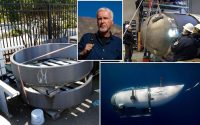30 years after the siege at Waco
There was a time when David Thibodeau didn’t think about the events outside of Waco, Texas. back in April 1993.
Now 54 and living in Maine, Thibodeau was too busy drumming in his band to allow himself to relive the horrors of what took place there. “In a way, you start to forget and it kind of goes away,” he tells The Post.
“But then you turn on the TV and there will be footage of the burning buildings and it all comes flooding back.”
Thibodeau was one of just nine people to leave the blazing Mount Carmel Center alive following a 51-day standoff between the FBI and the center’s residents – the religious community known as Branch Davidians.
The standoff ended in the deaths of 76 people, burned alive as FBI attempts to end the siege failed catastrophically.
Thirty years later, Thibodeau’s almost surreal recollections of what took place typify the experiences of the few who managed to survive – as well as many of the law-enforcement agents and negotiators who attempted to deliver them to safety.

The saga at Waco began on February 28, 1993, when 75 agents from the Bureau of Alcohol, Tobacco, and Firearms tried to serve an arrest warrant for weapons charges on David Koresh, leader of the Branch Davidians.
During the fracas, officers shot the group’s dogs, which prompted a gun battle with the compound’s residents that saw Koresh wounded along with four ATF agents and six Branch Davidians killed.
Born Vernon Howell in Houston, Texas, in 1959, Koresh had been a member of the Branch Davidians since 1981, becoming the leader in 1990 and changing his name in the process.

While previous leaders believed they were prophets of God, Koresh maintained he was the son of God – sent to Earth to prepare for the end of days while heading the messianic, apocalyptic Christian movement founded in 1955 as an offshoot of Seventh Day Adventism.
Under “orders” from God, Koresh took as many as 19 wives, reportedly fathering 13 children with them. His only legal wife was Rachel Jones, whom Koresh had married when she was just 14 years old.
Heather Jones was Rachel Jones’s niece, born at the compound in October 1983.

Her family’s association with the Davidians dated back to the 1950s when her grandparents became members around the same time the group established their headquarters 13 miles north of Waco.
“Growing up in Mount Carmel was fun at times,” she says. “We had lots of animals. We had a lake and a swimming pool.
“[But] I hated the long church services.”
Jones lost her grandfather, Perry, in the initial ATF raid and, later, her father, David, in the final assault almost two months later.
Her mother, Kathy, survived, having left Mount Carmel in 1990 when she separated from her husband.
Jones also lost her aunt Rachel, who died alongside the three children she had with Koresh, as well as another aunt, Rachel Jones’s sister, Michelle.
She still remembers being woken by the sound of bullets smashing through her bedroom walls and people nearby being wounded or killed when the ATF began the initial raid. “There is not one day that goes by that I don’t think about the events that happened in 1993,” she says.
“I’ll never have any closure.”
There’s widespread suspicion when writers such as myself contact those who were at Mount Carmel — ranks seem to close as word spreads about your interest in what transpired three decades ago.

On the “Branch Davidians Survivors Waco’ group on Facebook,” there are messages warning members to “trust no one.”
Former group member Kat Schroeder, whose husband died in the first ATF raid, is “pretty sure I’ve already answered every question that could be asked.”
Another Branch Davidian, Livingstone Fagan, can’t see the point in discussing Waco any further. “We’ve been down this road many times before,” he messages, before highlighting the “misinterpretation and disinformation” that typically occurs whenever Waco is discussed.
Fagan left the compound with his two children, Renae and Neharah, on March 23, but lost his wife, Evette, and mother, Doris Adina during the raid.

Losses endured by folks like Fagan and Jones were not untypical.
Ofelia Santoyo, who left on March 21, had her daughter, Juliette Martinez, 30, and her five grandchildren, aged 3-13, perish at Waco.
Sheila Martin, then 46, also left that day to be reunited with her two children, Kimberly and Daniel, who had been released earlier. But she left behind her husband, Douglas, and her four older children, all of whom died.
Among the dead, meanwhile, were 24 British followers – many recruited when Koresh toured the United Kingdom in the late 1980s looking for new followers.

A few hours after the ATF’s initial raid, FBI negotiator Gary Noesner was on a plane headed for Texas. “I don’t know that anyone can truly be prepared for an event as challenging as Waco,” he tells The Post. “It’s not so easy to come into such a scenario and say, ‘Forgot all the prior stuff, trust me, let’s make a deal and end this peacefully.’ ”
Noesner’s negotiating strategy sought to distance the FBI from the ATF’s more aggressive style and, in doing so, establish a new relationship with the Davidians.
“From the beginning, it was quite clear that Koresh had an inflated sense of self-importance,” he tells The Post. “But I believed he was still someone that we could find a way to work with.

“We didn’t lecture him. We found we achieved more when we stayed away from religion. “You cannot expect to talk someone out of their core beliefs.”
It seemed to work – at least initially.
In the first week of the standoff, 21 children were allowed to leave, including Heather Jones and her brothers, Kevin, 11, and Mark, 12.
Fourteen adults also left.
But no more.

Dick DeGuerin was the lawyer tasked with negotiating on Koresh’s behalf. Based in Houston, he was hired by Koresh’s mother, Bonnie Haldeman, but was initially denied access to his client.
One month after the first raid, however, DeGuerin was granted permission to speak with Koresh. “I made it clear that I was not a shill for the FBI,” DeGuerin tells The Post.
His first face-to-face meeting with Koresh was conducted through the compound’s front door, with DeGuerin sitting on a chair outside.
Later, he was allowed inside. “I found Koresh to be a very intelligent and articulate person,” recalls DeGuerin, now 82 and living in Houston. “He was also dyslexic but had still memorized the whole of the Bible.”

For DeGuerin, there was no problem working with Koresh. As he saw it, the force used by the ATF had initially been excessive, and Koresh’s resistance was understandable.
It’s a view later reinforced by the acquittal of 11 Branch Davidians on murder charges relating to the initial ATF raid in February 1994. “As a lawyer, my job was to defend David Koresh at any trial.
“Yes, he would probably be charged with murder or conspiracy to murder, but I had to convince him that he would be treated fairly under the criminal justice system.
“And I think we did.”

But progress was slow.
As the siege entered its fourth week, Noesner’s bosses began to change tack as a sense of fatigue set in. The FBI had more than 650 personnel at the compound and costs were mounting.
“They felt the best strategy was to ratchet up the pressure to force the Davidians out,” recalls Noesner. “[But] As a negotiator I knew this was not the way to go.”
Thibodeau agrees. “I think a lot of the Feds had never experienced anything like a religious group, committed to the scripture, that put God before everything,” he says.
Noesner left Mount Carmel on March 26, halfway through the siege as pressure mounted for a more aggressive approach. But “nobody came out after I was reassigned,” he says.

Still, by April 14, the situation appeared to be headed toward a nonviolent resolution. DeGuerin brokered a deal with Koresh for his surrender, providing his client was given time to complete his manuscript on the Seven Seals prophecy in the biblical Book of Revelations.
“I’d worked it out with the Texas Rangers that I would go in on the day of the surrender and walk out with Koresh and hand him over,” adds DeGuerin.
“Koresh even put it in writing.”
Thibodeau confirms this chain of events.
“I think a couple of more weeks at most and Koresh would have finished,” he says. “But the FBI thought it was another stalling tactic.” And the groundwork for the final – and fatal – assault began.
The following day, on April 15, FBI Commander Jeff Jamar headed to Washington, DC, to meet newly-appointed Attorney General Janet Reno and seek permission to end the standoff.

Various strategies were discussed, from digging tunnels to drugging the Davidians, but the preferred method – using tear gas and armored vehicles – was signed off on April 17.
Two days later, at around daybreak, the plan was put into action – with devastating consequences.
When the Davidians refused a final opportunity to surrender, the FBI, using tanks and combat vehicles, fired tear gas grenades through the building’s windows and smashed through walls.
A fire eventually broke out inside the compound. Fanned by strong winds, it tore through the large timber buildings.

David Koresh and 75 others died, including 22 children. Thibodeau still faults the government’s heavy-handed tactics.
“Those kids suffered immeasurably – I can’t imagine what they went through,” he says. “And yet the government asked why the kids just didn’t come out of the holes the tanks had made in the building.
“How the f–k do you grab your kids and come out with all that going on? Tell me that.”
Only nine people escaped with their lives, one of whom was Thibodeau. “Right place, right time” he reflects. “I climbed out a window because I didn’t want to burn to death.
“Yes, I thought they were going to shoot me but that’s what I would have preferred to be honest.”
Thirty years on, the blame game continues.

The FBI and the Justice Department maintain the Branch Davidians started the fire deliberately, while survivors insist it was the FBI’s tear gas that ignited the blaze.
Noesner believes the siege could have ended differently. “We had a chance to get everyone out alive but that’s not the general opinion of the FBI personnel there,” he says.
While some FBI actions were criticized in the official Danforth Investigation into Waco in 2000, federal officials were cleared of any wrongdoing, leading to accusations of a whitewash.
“At every single stage, the government were the aggressors,” says Thibodeau. “They came in with helicopters and tanks. They shot the dogs. Even when the negotiations were working, they increased the pressure.
Noesner, meanwhile, became Chief of the FBI Crisis Negotiation Unit and wrote a book about his career, “Stalling For Time: My Life as an FBI Hostage Negotiator.”

DeGuerin remains convinced Koresh would have surrendered. “It was just a matter of time,” he says.
While the siege was over, for survivors it was the start of a lifetime of trying to come to terms with events.
Heather Jones, for instance, is now a 39-year-old nurse living just 12 minutes away from Mount Carmel.
She still suffers from severe PTSD and remains angry about the coverup she believes happened. “I still live in fear to this day,” she says. “They will never tell the truth about what they did to us and all the horrible things they did to my family.
Thibodeau also still struggles to process what happened.
“The trauma stays with you on a cellular level,” said the author and musician. “And that’s a very hard way to live your life.”


